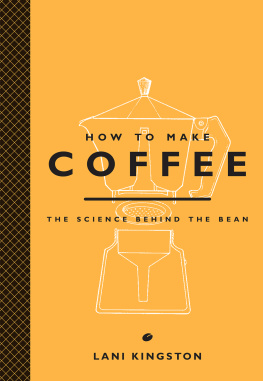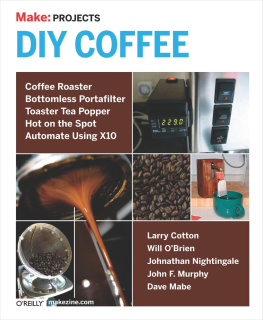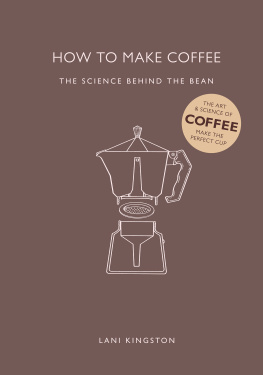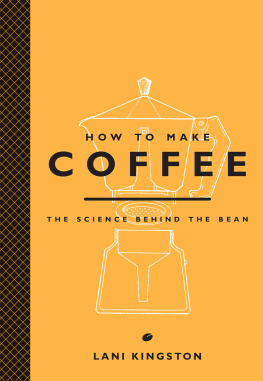HOW TO MAKE
COFFEE
THE SCIENCE BEHIND THE BEAN
LANI KINGSTON
ABRAMS IMAGE, NEW YORK
Editor: Sarah Massey
Designer: Ginny Zeal
Production Manager: Elizabeth Peskin
Library of Congress Control Number: 2014942740
Print ISBN: 978-1-4197-1584-6
eISBN: 978-1-61312-790-2
Text copyright 2015 Lani Kingston
Design and layout copyright 2015
Ivy Press Ltd
Published in 2015 by Abrams Image, an imprint of ABRAMS. All rights reserved.
No portion of this book may be reproduced, stored in a retrieval system, or transmitted in any form or by any means, mechanical, electronic, photocopying, recording, or otherwise, without written permission from the publisher.
This book was conceived, designed, and produced by
Ivy Press
210 High Street
Lewes, East Sussex
BN7 2NS, UK
Creative Director: Peter Bridgewater
Publisher: Susan Kelly
Editorial Director: Tom Kitch
Art Director: James Lawrence
Commissioning Editor: Sophie Collins
Editors: Jo Richardson & Jane Roe
Design & Graphics: Ginny Zeal
Illustrator: Sandra Pond
Color origination by Ivy Press Reprographics
While the publishers and the author have made every effort to ensure that the information contained in this book is accurate and presented in good faith, no warranty is provided nor results guaranteed. The publishers and author exclude liability to the fullest extent of the law for any consequences resulting from reliance upon the information.
Abrams Image books are available at special discounts when purchased in quantity for premiums and promotions as well as fundraising or educational use. Special editions can also be created to specification. For details, contact specialsales@abramsbooks.com or the address below.
ABRAMS
The Art of Books Since 1949
115 West 18th Street
New York, NY 10011
www.abramsbooks.com
TO MAKE ANY OLD CUP OF COFFEE, you simply need a pot, heat, ground coffee, and water. But youre not just anyone. You are a coffee aficionado, a determined, fearless seeker of the best java. And this is the guide for you.
How to Make Coffee provides an in-depth look at the art and science behind the bean. Learn about the anatomy of coffee; the chemistry of caffeine; the best way to roast, grind, and brew the beans to their peak flavor; and what gadgets you really need (versus what gadgets are for mere coffee dilettantes). With illustrated, step-by-step instructions, How to Make Coffee is for the person who doesnt want to settle for anything less than the perfect cup.
CONTENTS
INTRODUCTION
H ow to Make Coffee is not a recipe book, a bean anthology, or a lifestyle accessory; it is an explanation of the scientific principles behind the art of coffee making, with clear step-by-step instructions explaining how all the major coffee-making methods work, and which beans, roast, and grind are best for them.
Coffee percolated through to Europe around the time of the Renaissance. It came from Africa, where, according to one very appealing legend, it was discovered by goatsor at least by an observant goatherd who saw the effect a certain plant had on his livestock. It seems a very apposite product for its time: brought about by a blend of art, science, discovery, and human curiosity, just the kind of refreshment needed by the Renaissance brain on full alert to process the breakthroughs, inventions, creativity, and paradigm shifts of the era. Or maybe, given the effects of caffeine on the brain, it was one of the causes of the Renaissance...
Unlikely, but certainly it is the chemistry of coffee that makes it so compatible with the human body and brain, making it the worlds favorite drink. The molecular structure of caffeine, the active ingredient, is very similar to a compound in the human body that controls part of the nervous system. This compound, adenosine, turns down nerve activity, while caffeine blocks adenosine from connecting with its receptors and as such can effectively re-energize.
Coffee is the result of trying to turn caffeine into something the human body can safely use. Growing, harvesting, processing, roasting, grinding, blending, mixing with water, applying heat, extracting, brewing, creating machinery to refine the processes: these are all science-driven applications. Understanding the science of coffeeits botany, geography, chemistry, physics, engineeringas well as the artblending and balancinghelps to create the perfect cup of coffee. If you understand, for example, why water has to be a certain temperature, how the size of the coffee particles can affect extraction, what the ideal proportion of coffee solids to water is, the different rates at which compounds are soluble, and how long brewing continues in the cup, you have grasped the principles behind coffee making, by whatever method, and you and your guest need never suffer a bitter cup of gritty, overboiled coffee or weak watery slop again.
SECTION ONE
The Bean

THE BEAN BELT
C offee is one of the worlds most valuable traded natural commodities, second only to oil, and it is produced and consumed worldwide. The prized bean is believed to have originally evolved in the wild in East Africa, but global exploration introduced it to many different cultures. Today, coffee is cultivated in more than seventy countries in an area known as the bean belt.
THE BEGINNINGS OF COFFEE CULTURE
Although the precise origins of the consumption of coffee remain uncertain, it was likely first discovered in Ethiopia. It is thought that at some point before 1000 CE Ethiopian tribes began to grind the coffee fruits containing the coffee seeds or beans and mix them with an animal fat, making a kind of energy bar to sustain them on hunting trips or long journeys. Some nomadic tribes continue to consume these bars even today.
One popular legend has it that coffees fortuitous introduction to the human race came about when a young Ethiopian goatherd found his goats prancing tirelessly after chewing on an unusual plant. Having sampled some of it himself and feeling energized as a consequence, the goatherd brought some of the magical plant back to his community. Word spread, and the rest is history.
The earliest evidence of human cultivation of the coffee plant has been traced back to the fifteenth century in Yemen. As with accounts of the discovery of coffee, just how it traveled to the Arabian Peninsula is largely a matter of conjecture. Some stories tell of Sudanese slaves chewing on coffee fruits to help them survive the journey from Ethiopia to Arabia; some tell of an Islamic scholar observing the invigorating effects of coffee on a trip to Ethiopia and bringing it back on his return to the Arabian Peninsula. Yet other tales view the spread of coffee simply as the result of the ongoing trade that existed between the two places.

An engraving of a seventeenth-century German coffeehouse.
Whatever the precise course of events, fifteenth-century Sufi monks imbibed coffee as a beverage to help keep them awake during their nighttime prayers. It wasnt long before the drink became popular with the rest of the population, particularly the Muslims, who for religious reasons were barred from consuming intoxicating beverages, such as alcohol. Coffeehouses, known as kaveh kanes, multiplied throughout the Arab world, becoming communal hubs for socializing, education, and general merriment.
Next page












